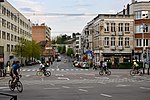Trône/Troon metro station
Belgian railway station stubsBrussels Metro stubsBrussels metro stationsCity of BrusselsRailway stations opened in 1970

Trône (French) or Troon (Dutch) is a Brussels metro station on the southern segment of lines 2 and 6. It is located under the small ring at the Place du Trône/Troonplein, near the Royal Palace of Brussels, in the municipality of the City of Brussels (Belgium). The station opened as a premetro (underground tram) station on 20 December 1970 under the name Luxembourg. It became a heavy metro station on 2 October 1988 and its name was changed to reflect the neighbouring Place du Trône/Troonplein ("Throne Square").
Excerpt from the Wikipedia article Trône/Troon metro station (License: CC BY-SA 3.0, Authors, Images).Trône/Troon metro station
Avenue des Arts - Kunstlaan, City of Brussels
Geographical coordinates (GPS) Address Nearby Places Show on map
Geographical coordinates (GPS)
| Latitude | Longitude |
|---|---|
| N 50.841111111111 ° | E 4.3663888888889 ° |
Address
Trône - Troon
Avenue des Arts - Kunstlaan
1000 City of Brussels (Brussels)
Belgium
Open on Google Maps






